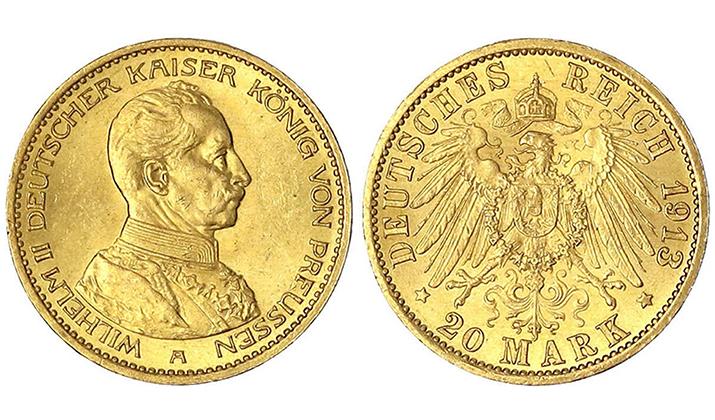In the broad expanse of numismatic treasures, the coins of Germany carve a distinct space that’s steeped in historical richness, diverse culture, and unparalleled craftsmanship. The allure of German coins extends beyond their value as currency; they serve as a tangible testament to the country’s compelling past, its epochs of power, eras of turmoil, and moments of triumph. This is not just about coins; it’s about a voyage through the annals of German history, one coin at a time. What are the best German gold coins?
Germany, as we know it today, is relatively young. Born from the ashes of division after World War II, its coinage reflects the various states and regimes that have held power throughout its history. While it might be tempting to plunge into a list of these numismatic gems right away, it’s crucial to first understand their historical and cultural context, for it adds layers of meaning to the stories these coins tell.
Each German coin carries with it a fascinating narrative, a reflection of the era from which it was born. From the intricate craftsmanship of Medieval times, to the evocative symbolism of the Weimar Republic era, and the post-war issues that bear testimony to a nation’s resurrection – every single piece invites us into a compelling tale of change, resilience, and innovation.
These coins are works of art. They bear designs crafted by some of the most talented engravers of their times, capturing a slice of life from the era they represent. The intricate detailing on each coin tells us about the artistic sensibilities prevalent during its mintage, making them not just valuable monetary pieces, but significant cultural artifacts.
As a collector or a history enthusiast, diving into the ocean of German coinage is a thrilling adventure. You’ll not only marvel at the beautiful designs and the precious metals, but you’ll also learn about the monarchs, revolutions, and the political and socio-economic conditions that shaped a nation.
Before we delve into the intricacies of these marvelous coins, let’s first set our footing in the numismatic terminology and the basic understanding of coin grading. We will also discuss the ways to start your own collection, the factors that influence the value of the coins, and how to preserve these treasures.
So come, join us in this intriguing journey through the lanes of German history, as we unfold the story of its coinage – where art meets history, and where each coin has a captivating tale to tell. Stay tuned to our series of blog posts dedicated to German numismatic treasures, a unique world that combines the charm of collecting, the thrill of history, and the allure of fine art.
So whether you’re a seasoned numismatist looking to expand your collection or a curious beginner stepping into this captivating world, this blog series promises to be an exciting and enlightening expedition into the numismatic heart of Germany. Let the journey begin!
The Prussian Gold 20 Marks
The Prussian Gold 20 Marks is one of the most sought-after pieces among collectors and enthusiasts of German numismatics. The history and value of these gold coins go beyond their monetary worth, reflecting a significant era in Germany’s history.
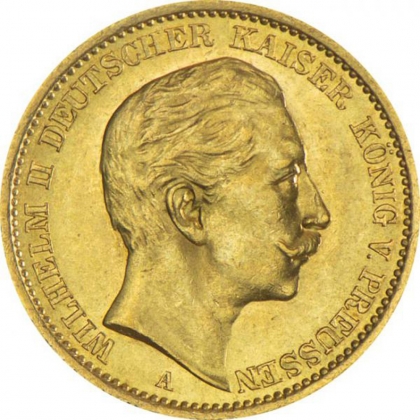
The Prussian Gold 20 Marks coins were minted from 1871 until the start of World War I in 1914. They were struck in the Kingdom of Prussia, which was the leading state of the German Empire, a powerhouse in the heart of Europe.
One of the most intriguing features of the Prussian Gold 20 Marks is the series of portraits it carries. Depending on the year of issue, the obverse of the coin features a beautifully engraved portrait of one of the Prussian rulers. These include Wilhelm I (1871-1888), Frederick III (1888), and Wilhelm II (1888-1914).
The reverse side of the coin usually features the crowned arms of the German Empire, along with the denomination and the year of mintage. The design is surrounded by the legend, “DEUTSCHER KAISER KÖNIG V. PREUSSEN” (German Emperor, King of Prussia).
Made from .900 fine gold, the Prussian Gold 20 Marks weigh around 7.965 grams and contain about 7.168 grams of pure gold. Their high gold content combined with their historical significance makes these coins a valuable asset and a sought-after collectible. The first one of my German gold coins list!
The 1913 “A” Silver 3 Mark
The 1913 “A” Silver 3 Mark is a fascinating piece in the world of numismatics, exuding a profound historical aura that speaks of a bygone era in German history. Minted in celebration of the 25th anniversary of Kaiser Wilhelm II’s reign, this commemorative coin serves as an embodiment of a crucial period in Germany’s past.
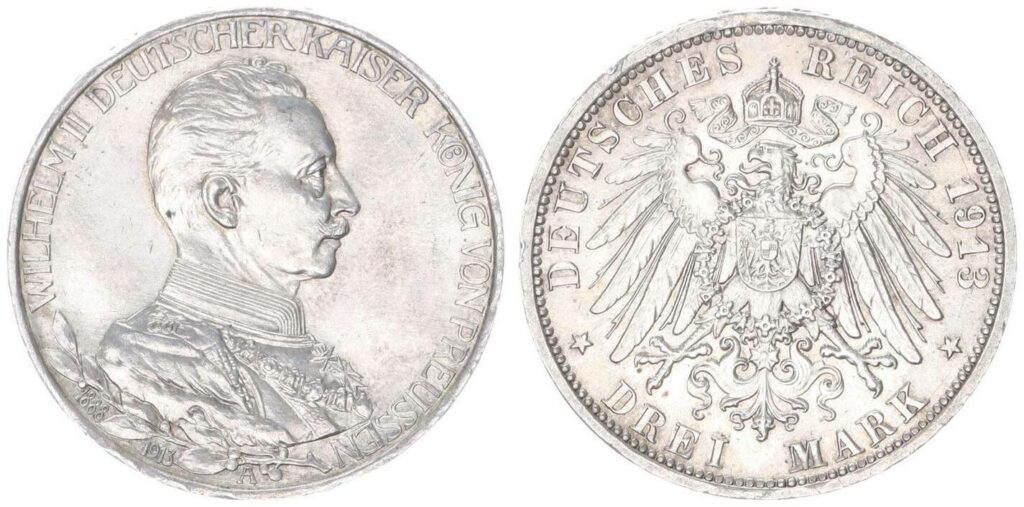
On the obverse of the coin, you’ll find an intricate portrait of Kaiser Wilhelm II dressed in a military uniform. As the last German Emperor and King of Prussia, his rule from 1888 to 1918 was marked by significant political and cultural changes, culminating in World War I. This detailed depiction adds a palpable sense of history to the coin.
The reverse side, on the other hand, proudly displays the Imperial German Eagle, a long-standing symbol of the nation’s sovereignty. The denomination “DREI MARK” (Three Mark), the Berlin mint mark “A”, and the year of mintage, 1913, are also inscribed on this side of the coin.
The 1913 “A” Silver 3 Mark coin is crafted from .900 fine silver, with a weight of approximately 16.67 grams and a diameter of 33mm. A unique aspect of this coin is its edge inscription, which reads “GOTT MIT UNS” or “God with us” – a motto often associated with the German military.
For collectors, the 1913 “A” Silver 3 Mark coin holds value beyond its precious metal content. Its connection to Kaiser Wilhelm II and the era preceding World War I lend it immense historical significance. The actual monetary worth of the coin can vary based on a variety of factors, including its condition, the rarity of the coin, and the fluctuating market value of silver.
Collecting a coin like the 1913 “A” Silver 3 Mark is akin to possessing a piece of history. It offers a tangible glimpse into Germany’s imperial past and is a noteworthy addition to any numismatic collection. As we admire the craftsmanship and historical resonance of this coin, we are reminded of the intricate ways in which history, culture, and artistry intertwine in the world of coinage. The second one of my German gold coins list!
Weimar Republic 5 Reichsmark Coins
The Weimar Republic 5 Reichsmark coins serve as compelling historical artifacts from a period of tremendous change in Germany. Struck in the period between World War I and World War II, these coins bear witness to the tumultuous era of the Weimar Republic, a time characterized by political instability, economic crisis, and ultimately, the rise of the Third Reich.
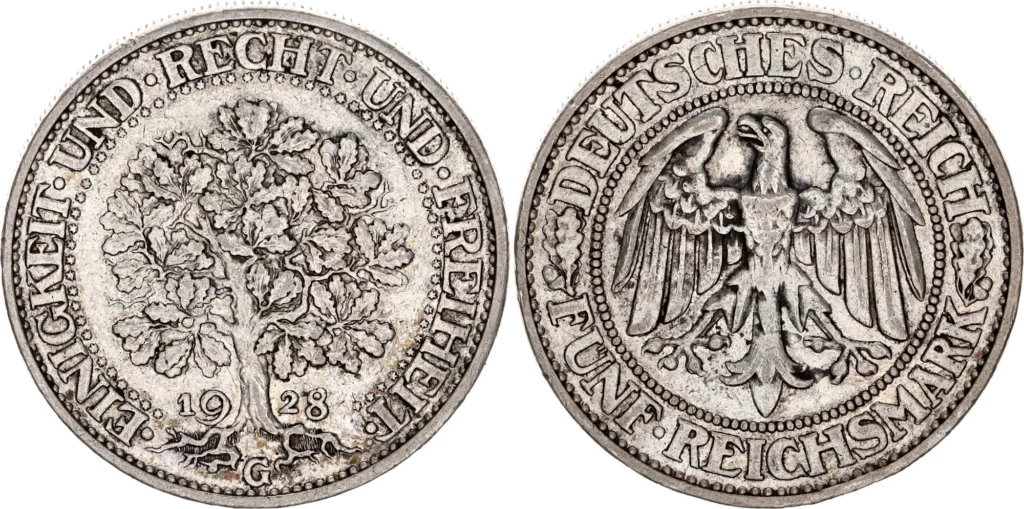
The 5 Reichsmark coins are known for their aesthetic appeal and symbolic imagery. The obverse side typically displays an eagle, a longstanding emblem of Germany. This image underwent various modifications during the Weimar Republic period, reflecting the changing times and shifting ideologies.
On the flip side, the reverse of these coins often showcases the iconic “Germania” figure, an allegorical representation of Germany, standing next to an oak tree, a symbol of strength and steadiness. This depiction creates a powerful visual narrative about the nation’s resilience during a challenging period in history.
Minted from .500 fine silver, the 5 Reichsmark coins have a diameter of 29mm and weigh about 13.88 grams. Some versions, particularly commemorative issues, may contain .900 silver and have different weights and diameters.
The value of these coins for collectors often extends beyond their silver content. As they reflect a significant era in German history, their worth can be influenced by factors such as the specific year of mintage, the overall condition of the coin, and the historical events linked to its issue.
In essence, the Weimar Republic 5 Reichsmark coins embody a complex and pivotal chapter of Germany’s past. Whether you’re a seasoned numismatist or a history enthusiast, these coins provide a fascinating glimpse into an era of transition and transformation, making them a captivating addition to any collection. The fourth one of my German gold coins list!
Bavarian Silver 5 Mark
The Bavarian Silver 5 Mark coin is a cherished artifact among numismatic collectors, offering a rich historical connection to one of Germany’s most prominent states. Minted in the Kingdom of Bavaria during the late 19th and early 20th centuries, these coins form an important part of the German monetary history.
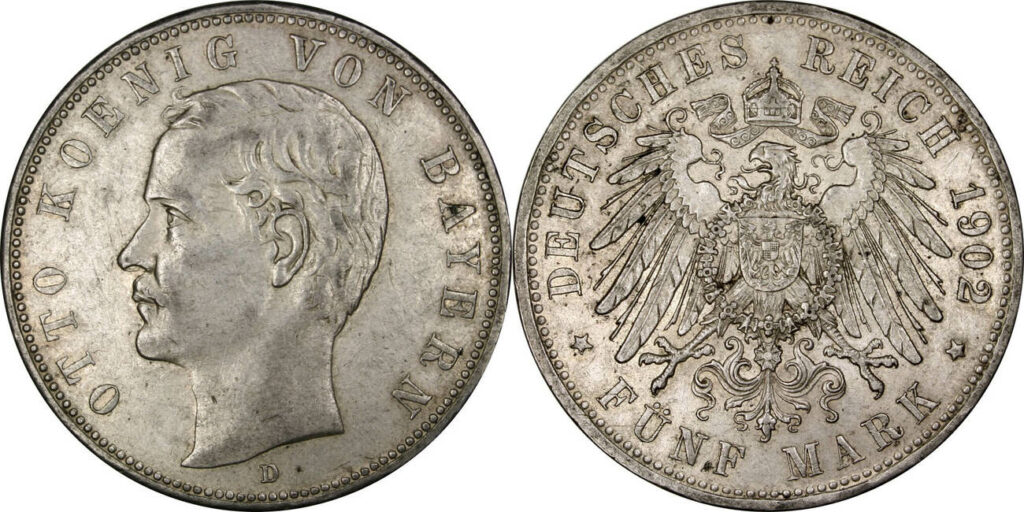
The obverse side of the Bavarian Silver 5 Mark coin often features an exquisite portrait of the King of Bavaria. One notable example is King Ludwig II, known as the “Fairytale King” for his construction of grand castles like Neuschwanstein. Ludwig II’s rule from 1864 to 1886 was a period marked by personal eccentricity and grand architectural projects, which has led to his enduring fascination among historians and the public alike.
On the reverse, the Bavarian Silver 5 Mark coins typically showcase the arms of the Kingdom of Bavaria. This traditional coat of arms, featuring lions and a shield with the blue and white lozenges of Bavaria, is a powerful emblem of Bavarian statehood and identity.
The coin is minted from .900 fine silver, weighing approximately 27.77 grams with a diameter of 38mm. It carries a face value of 5 Marks, although its worth today as a collector’s item can be significantly higher, depending on factors such as its condition, the year of minting, and the historical significance of the period it represents.
To hold a Bavarian Silver 5 Mark coin is to hold a piece of Bavarian history. These coins offer more than just monetary value; they serve as a link to a past era, a tangible reminder of the fascinating figures and historical events that have shaped Bavaria and, by extension, Germany as a whole. As such, they’re a meaningful and intriguing addition to any numismatic collection. The fifth one of my German gold coins list!
The East German 20 Mark Coins
Struck by the German Democratic Republic (GDR), also known as East Germany, these coins serve as tangible reminders of the post-WWII division of Germany and the era of the Cold War.
The East German 20 Mark Coins are unique because they feature different cultural or political figures each year. These range from noteworthy scientists to prominent political leaders, providing an intriguing glimpse into the individuals East Germany chose to celebrate during its existence from 1949 to 1990.
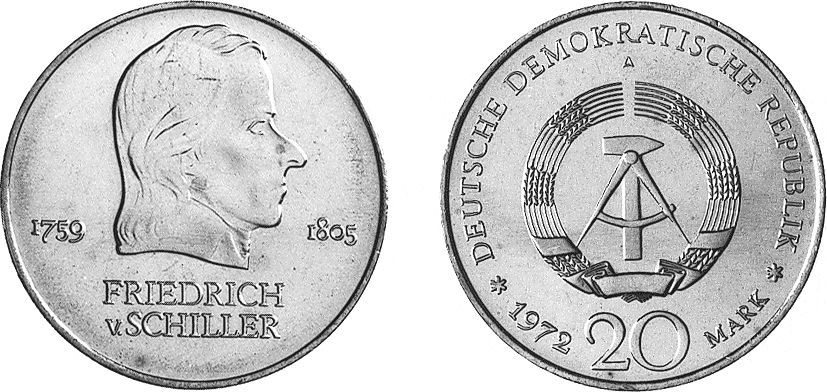
Typically, the obverse side of the coin features a finely detailed portrait of the honored figure of the year. The reverse, on the other hand, usually presents the state emblem of the GDR—an emblematic compass and a hammer encircled by rye, symbolizing the worker, the intellectual, and the farmer, respectively.
These coins were minted in .900 fine silver, weighing about 22.2 grams and with a diameter of 33mm. Though they bear a face value of 20 Marks, the true value of these coins often surpasses their nominal worth, considering their historical significance and silver content.
The East German 20 Mark Coins’ value to collectors lies not only in their physical attributes but also in the narrative they encapsulate. They serve as a stark reminder of a divided Germany and represent the ideals and figures that shaped East Germany during its four decades of existence.
For coin collectors and history buffs alike, these coins offer a chance to explore and appreciate an important chapter in Germany’s past. Whether it’s the exquisite design, the notable figures depicted, or the historical weight they carry, the East German 20 Mark Coins undoubtedly make a fascinating addition to any collection. The sixth one of my German gold coins list!
